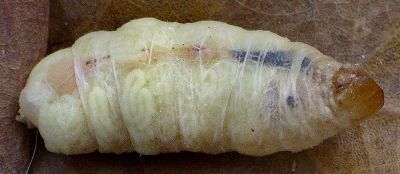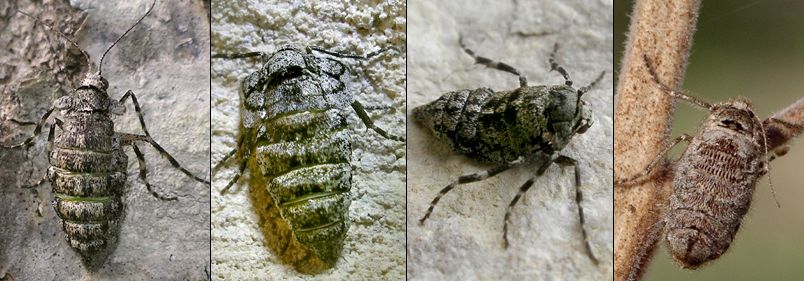
female bagworm moth
Because of the large number of moths, it is not surprising that there are a fair number of unusual adaptations within the group. Some daytime feeding moths resemble wasps so that they may feed undisturbed by visual predators. Some of our most spectacular adult moths do not feed. The caterpillars of the giant silkmoths do all the eating, and when the beautiful adults emerge from their cocoons their only activities are to mate and lay eggs. They live less than a week. Some moth caterpillars have poisonous spines for protection, while others have strange behaviors like flinging themselves off a plant if attacked, extending special projections with chemical defenses, or shooting their fecal pellets several feet away so that their proximity will not lure predators directly to the insects.
One of the more bizarre adaptations of moths is the loss of wings. While a disembodied wing of a large moth is easily recognized for what it is, a moth body without wings is VERY strange looking indeed. Out of a large number of species, only a few moths have lost their wings. And only females. The big advantage to wings is mobility, especially when it comes to feeding or finding the opposite sex. However, flying is more dangerous than staying put. A common strategy for many species of moths involves the females resting in a hidden place and emitting pheromones to attract the males, which have sensitive antennae and strong wings to locate and reach them. Once a female has mated, then she may fly off to lay eggs on an appropriate host plant for the caterpillars. Or, better yet, she might not waste any time and just lay the eggs right where she is. In this case, either the host plant is nearby or the newly hatched larvae are responsible for making their way to food. Some hatchlings are adapted to travel just by crawling fast, but one of the most interesting ways a tiny caterpillar flies the coop is quite literal: it flies away. Of course it doesn't have wings, but caterpillars can produce a strand of silk from glands near their mouth and, like a spider releasing silk to catch a breeze and carry it into new territory (a behavior known as "ballooning"), the baby insect can launch itself onto an air current and, hopefully, end up on something edible.
 female bagworm moth |
So if the caterpillars can do the traveling and all a female moth has to do is produce an alluring scent to attract a male, she has no need to ever leave the safety of the wall, stick, or tree trunk onto which she has crawled after emerging from her pupa. If she never needs to fly, what good is expending the energy to produce wings? Just as eyes of cave-dwelling animals tend to disappear through the generations, if there is no advantage to having wings, they aren't worth allotting resources to their production. Obviously, this evolutionary road is not for the majority of moths, as most species do have both males and females capable of flight. The diversity of environments and the available niches to be filled, though, just about guarantee that if a survival strategy is capable of success, it will be used by at least a small portion of the fauna population.
Here in central Texas there are two very different groups of moths that exhibit wingless females: the bagworms (psychidae) and a small number of inchworm moths (geometridae). The bagworms have the most extreme adaptation. Named for the silk cases they build around themselves, bagworms live their entire caterpillar life inside a portable shelter, similar to that which caddisflies make in the water. As the larva feeds, it puts bits of its host plant twigs and/or leaves into the silk case, giving it stability and camouflage. When the caterpillar is ready to pupate, it does so in the nice snug retreat it has built. Males and females diverge at this point. The male moths will leave their pupa shell and "bag" and fly off. The females, though, will never leave the safety of their cases. The males must fly to them in order to mate. The females then just lay the eggs inside of their sacs and die. It is very rare to see a female, as they almost never emerge into the open. They do not develop wings, or legs, or hair, or even color, as all these things would only be necessary if they had to live outside. The mature female bagworm moth looks like nothing more than a sac of eggs with a head. All the resources within her body are channeled into producing a vast number of eggs.
While the bagworm female is really grotesque-looking from a human perspective, the wingless females of four common springtime geometrid moths are strange, but not repulsive. The males of the Spring Cankerworm (Paleacrita vernata), Small Phigalia (Phigalia strigataria), Halfwing (Phigalia titea), and Woolly Gray (Lycia ypsilon) frequently show up at outdoor lights in February and March. They are large enough to be noticed, and their wing patterns are rather attractive. The females, on the other hand, only very occasionally climb up walls near lights. They are just as likely to crawl in the dark up a tree, fence post, or any vegetation that happens to be around. Although the females' bodies are actually larger than those of the males, the insects look much smaller because they don't have the added bulk of wings. They are very chubby, as their bodies are, like the bagworm, filled with eggs that only need to be fertilized before the females can deposit them and expire.

The first time I saw a wingless female moth, I had no clue what it was. But, as with numerous insect species around Austin, I finally figured out what they were and how to tell them apart. The female Spring Cankerworm (named for the caterpillar) is the hairiest, while the Small Phigalia is rather sleek and shows some bright green between its body segments. The one female I have still not seen is the Woolly Gray. It should be quite fuzzy; the species is rather uncommon around here so it might be awhile before I am lucky enough to find one. The Halfwing is named in honor of the female, which has tiny useless wings!
During the end of winter, as soon as nighttime temperatures sometimes remain above 50°F, look for these curious wingless female moths. The eggs they lay before new leaves are even sprouted on the trees will eventually produce caterpillars that help to feed the hungry nestlings of countless songbirds.